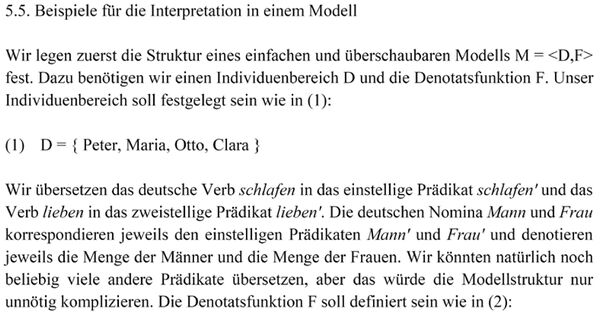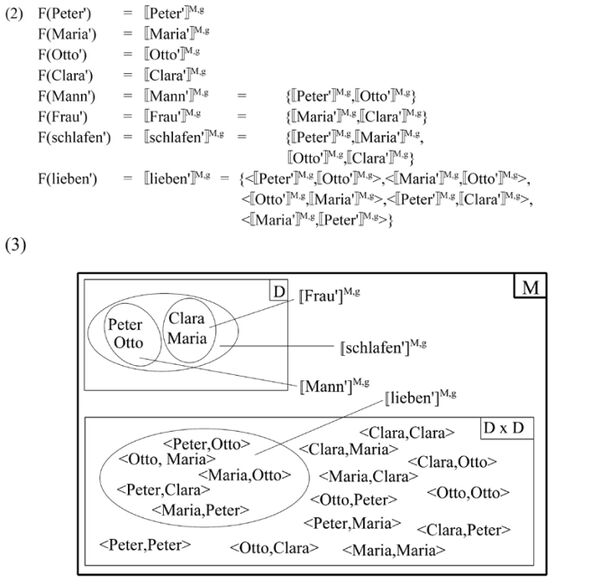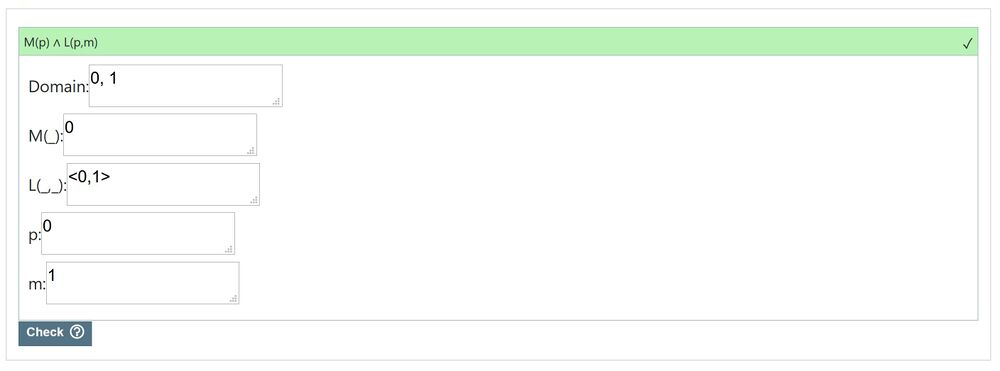Semantics 2: Difference between revisions
No edit summary |
|||
| (36 intermediate revisions by the same user not shown) | |||
| Line 2: | Line 2: | ||
<font size="3"> | <font size="3"> | ||
== Exercises on Models == | |||
In this week's class, we introduced models in which to inpret the expressions of first order logic. Here is an exerpt from Lohnstein(2011) that explains the basics: | |||
<br> | |||
[[File:Lohnstein-Models-1JPG.JPG | 600px]] | |||
[[File:Lohnstein-Models-2.JPG | 600px]] | |||
In order to practice the relationship between formulas and models, you are going to do 2 exercises. In the first exercise, you are supposed to create models that make a formula true and in the second one models that make the formula false. | |||
You do the exercises on [https://carnap.io/ Carnap]. | |||
== Models in Carnap == | |||
The models in Carnap are written in a different format from the standard format which you saw above, but the two notations mean'''exactly the same'''! Here is an example of a possible model in Carnap: | |||
[[File:Carnap-model.JPG | 1000px]] | |||
In the standard format, this model would be written as follows: | |||
M = <D, F> such that | |||
D = {0, 1} | |||
F(M) = {0} | |||
F(L) = {<0,1>} | |||
F(p) = 0 | |||
F(m) = 1 | |||
Here are important rules for formulating models in Carnap: | |||
# Only single upper and lower case letters are permitted as non-logical constants. | |||
# Lower case letters are names. So, instead of "maria'" you need to write "m". | |||
# Upper case letters are n-place constants (the arity is not part of the name). So, instead of "Frau'" you need to write "F". | |||
# You do not have to write sets in terms of curled brackets. Just list the members of the set separated by commas. Make sure that after the last member of the set, there are no further symbols, including spaces! As I found out that leads to an error message. | |||
# Ordered pairs are written with the symbols "<" and ">". So, <4,3> is the ordered pair of 4 and 3. | |||
# Unfortunately, Carnap is also sparse in allowing only whole positive integers as members of the domain. One way to think about that is that the models just give each individual its own number. | |||
# I have put the constraint on the models that every name has to denote a different entity from the domain as all the other names. | |||
# When Carnap displays a model at first, it already puts some information into the model, as follows: | |||
## the domain already contains the entity 0 | |||
## Each name is already assigned a denotation. At first, all names denote the individual 0. Since I don't allow for 2 names to refer to the same individual, you must give each name a different denotation (counting from 0 upwards). Of course, if you introduce denotations other than 0 for names, you must add these denotations to the domain. | |||
## Each constant is listed with its arity shown in parentheses. That tells you whether its extension is a set of individuals or a set of ordered pairs. | |||
# To make things easier on you, I give a key over each model that gives the intended interpretation of single letters. For instance, the key contains the pair below which means that the model's name for Maria is "m". | |||
m Maria | |||
I hope this information is enough to allow you to complete the exercises! If you encounter problems, then please write a message into the forum and I will help! | |||
'''Important:''' Note that Carnap's terminology is sometimes different from what we have used in class. In particular, what we have called ''denotation'' is called ''extension'' by Carnap. So, for example, if you have used a referent as the denotation of the name or part of the denotation of a predicate, but forgot to add it to the domain of the model, you get the feedback that "The extension of ... is not contained in the domain." | |||
[[Semantics|Unit 1]] Unit 2 [[Semantics_3|Unit 3]] | |||
<!-- | |||
'''Key:''' | '''Key:''' | ||
{| class="wikitable" | {| class="wikitable" | ||
|- | |- | ||
| Z<sup>1</sup> = <span style="color: red>'''_'''</span> is an element<br>|| H<sup>1</sup> = _ is big<br>|| Q<sup>2</sup> = _ is directly above _<br> | | Z<sup>1</sup> = <span style="color: red>'''_'''</span> is an element<br>|| H<sup>1</sup> = <span style="color: red>'''_'''</span> is big<br>|| Q<sup>2</sup> = <span style="color: red>'''_'''</span> is directly above <span style="color: red>'''_'''</span><br> | ||
|- | |- | ||
| A<sup>1</sup> = <span style="color: red>'''_'''</span> is a circle<br>|| J<sup>1</sup> = _ is medium<br>|| R<sup>2</sup> = _ is directly below _ | | A<sup>1</sup> = <span style="color: red>'''_'''</span> is a circle<br>|| J<sup>1</sup> = <span style="color: red>'''_'''</span> is medium<br>|| R<sup>2</sup> = <span style="color: red>'''_'''</span> is directly below <span style="color: red>'''_'''</span> | ||
|- | |- | ||
| B<sup>1</sup> = <span style="color: red>'''_'''</span> is a triangle<br>|| K<sup>1</sup> = _ is small<br>|| S<sup>2</sup> = _ is directly to the left of _ | | B<sup>1</sup> = <span style="color: red>'''_'''</span> is a triangle<br>|| K<sup>1</sup> = <span style="color: red>'''_'''</span> is small<br>|| S<sup>2</sup> = <span style="color: red>'''_'''</span> is directly to the left of <span style="color: red>'''_'''</span> | ||
|- | |- | ||
| C<sup>1</sup> = <span style="color: red>'''_'''</span> is a square<br>|| | | C<sup>1</sup> = <span style="color: red>'''_'''</span> is a square<br>|| || T<sup>2</sup> = <span style="color: red>'''_'''</span> is directly to the right of <span style="color: red>'''_'''</span> | ||
|- | |- | ||
| D<sup>1</sup> = <span style="color: red>'''_'''</span> is green<br>|| N<sup>2</sup> = _ is bigger than _|| W<sup>3</sup> = _ is directly between _ and _ | | D<sup>1</sup> = <span style="color: red>'''_'''</span> is green<br>|| N<sup>2</sup> = <span style="color: red>'''_'''</span> is bigger than <span style="color: red>'''_'''</span>|| W<sup>3</sup> = <span style="color: red>'''_'''</span> is directly between <span style="color: red>'''_'''</span> and <span style="color: red>'''_'''</span> | ||
|- | |- | ||
| E<sup>1</sup> = <span style="color: red>'''_'''</span> is red<br>|| O<sup>2</sup> = _ is smaller than _<br>|| Q<sup>2</sup> = _ is directly above _<br> | | E<sup>1</sup> = <span style="color: red>'''_'''</span> is red<br>|| O<sup>2</sup> = <span style="color: red>'''_'''</span> is smaller than <span style="color: red>'''_'''</span><br>|| Q<sup>2</sup> = <span style="color: red>'''_'''</span> is directly above <span style="color: red>'''_'''</span><br> | ||
|- | |- | ||
| G<sup>1</sup> = <span style="color: red>'''_'''</span> is blue<br>|| P<sup>2</sup> = _ has the same size as _<br> || | | G<sup>1</sup> = <span style="color: red>'''_'''</span> is blue<br>|| P<sup>2</sup> = <span style="color: red>'''_'''</span> has the same size as <span style="color: red>'''_'''</span><br> || | ||
|} | |} | ||
Key: | Key: | ||
| Line 45: | Line 100: | ||
Q<sup>2</sup> = _is directly above _<br> | Q<sup>2</sup> = _is directly above _<br> | ||
R<sup>2</sup> = _is directly below _<br> | R<sup>2</sup> = _is directly below _<br> | ||
Name = {a, b, c, d, e, f}<br> | Name = {a, b, c, d, e, f}<br> | ||
| Line 60: | Line 114: | ||
F(e) = 5<br> | F(e) = 5<br> | ||
F(f) = 6<br> | F(f) = 6<br> | ||
--> | |||
Latest revision as of 12:07, 3 February 2021
Exercises on Models
In this week's class, we introduced models in which to inpret the expressions of first order logic. Here is an exerpt from Lohnstein(2011) that explains the basics:
In order to practice the relationship between formulas and models, you are going to do 2 exercises. In the first exercise, you are supposed to create models that make a formula true and in the second one models that make the formula false.
You do the exercises on Carnap.
Models in Carnap
The models in Carnap are written in a different format from the standard format which you saw above, but the two notations meanexactly the same! Here is an example of a possible model in Carnap:
In the standard format, this model would be written as follows:
M = <D, F> such that
D = {0, 1}
F(M) = {0}
F(L) = {<0,1>}
F(p) = 0
F(m) = 1
Here are important rules for formulating models in Carnap:
- Only single upper and lower case letters are permitted as non-logical constants.
- Lower case letters are names. So, instead of "maria'" you need to write "m".
- Upper case letters are n-place constants (the arity is not part of the name). So, instead of "Frau'" you need to write "F".
- You do not have to write sets in terms of curled brackets. Just list the members of the set separated by commas. Make sure that after the last member of the set, there are no further symbols, including spaces! As I found out that leads to an error message.
- Ordered pairs are written with the symbols "<" and ">". So, <4,3> is the ordered pair of 4 and 3.
- Unfortunately, Carnap is also sparse in allowing only whole positive integers as members of the domain. One way to think about that is that the models just give each individual its own number.
- I have put the constraint on the models that every name has to denote a different entity from the domain as all the other names.
- When Carnap displays a model at first, it already puts some information into the model, as follows:
- the domain already contains the entity 0
- Each name is already assigned a denotation. At first, all names denote the individual 0. Since I don't allow for 2 names to refer to the same individual, you must give each name a different denotation (counting from 0 upwards). Of course, if you introduce denotations other than 0 for names, you must add these denotations to the domain.
- Each constant is listed with its arity shown in parentheses. That tells you whether its extension is a set of individuals or a set of ordered pairs.
- To make things easier on you, I give a key over each model that gives the intended interpretation of single letters. For instance, the key contains the pair below which means that the model's name for Maria is "m".
m Maria
I hope this information is enough to allow you to complete the exercises! If you encounter problems, then please write a message into the forum and I will help!
Important: Note that Carnap's terminology is sometimes different from what we have used in class. In particular, what we have called denotation is called extension by Carnap. So, for example, if you have used a referent as the denotation of the name or part of the denotation of a predicate, but forgot to add it to the domain of the model, you get the feedback that "The extension of ... is not contained in the domain."


